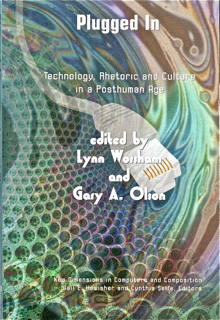Plugged In: Technology, Rhetoric and Culture in a Posthuman Age Edited by Lynn Worsham and Gary A. Olson (2008)
Part 2: Rhetoric and Writing in a Digital Age
These three essays address technology and networks as modes of practice and politics while suggesting strategies of negotiation and resistance. In a collaborative essay entitled "The Available Means of Persuasion: Mapping a Theory and Pedagogy of Multimodal Public Rhetoric," David Sheridan, Jim Ridolfo, and Anthony Michel lament the "reductive, limiting ways" that civic and multimodal projects only allow students to "write about the civic sphere, not in it" (p. 62). Locating a shift in Aristotelian, literate-based thinking, Sheridan, Ridolfo, and Michel maintain that recognizing kairos in multimodal arguments comes through an increased awareness of the image industry's influence. This industry, in the authors' opinions, displays so-called neutral content as objective Truth. Such presentation is thereby divorced from any consideration of the a priori and, in contrast, subjective politics of representation. They aim to place deliberative rhetoric within a digital media ecology in which students' awareness of the manipulation of the "semiotics of concealment" can lead to politically efficacious moments of kairos in production.
“Using computers in composition pedagogy feels like a prosthesis that either compensates for a lack of control or frustrates when we can't control it. What we experience, then, is a psychological phantom pain associated with a threat to the self.” ~Cynthia Haynes |
|---|
Equally as concerned as Sheridan, Ridolfo, and Michel about civic participation, M.J. Braun explores a more explicitly posthuman related area of composition scholarship in her article, "The Political Economy of Computers and Composition: 'Democracy Hope' in the Era of Globalization." Across a range of scholars and divergent methodologies, Braun locates limitations in past and current theorizations of capitalism and technology. Even James Berlin's or Cynthia Selfe's distinct efforts, for example, to overcome the luddite ("technophobe") and cyborg ("technophiles") theoretical impasse relies, in Braun’s mind, upon overdetermined notions of capitalism as "micro-practices" and underdetermined "macro-processes" (p. 97). The fetishism of micro-practices that instrumentalize technology often results in what Braun identifies as a latent progressive dream of "democracy hope" (p. 97). As such, thinking is decontextualized from macro-practices of capitalism, and she urges technology theorists to consider micro-practices dialectically through structures that condition user communities.
Continuing to trace intersections of capital and technology, James J. Sosnoski and Ken S. McAllister read against the grain of the often uncritical enthusiasm for "electronic educational environments" (EEEs) in "Circuitous Subjects in their Time Maps." In either non-dialogical (DVDs, static websites) or dialogical (MUDs, MOOs, MMORPGs) interfaces, Sosnoski and McAllister posit an Althusserian theory of interpellation with regard to writing and reading in EEEs. In the latter, "an avatar's 'I' […] is subjected to the discourse invented for it" through a combination of the game interface and user community's symbolically pre-structured communicative norms (p. 130). In the former, they maintain, even the arrangement of data and the nodes of access necessarily call (hail) users to subject positions beyond their instrumental control.Creating awareness of this interpellative process requires an examination of non-dialogical EEE's creation of "Identificatory subjugation" — a process "at the heart of the privatization of culture" (p. 136).
"A word for the "real but abstract” incorporeality of the body is the virtual. The extent to which the virtual is exhausted by “potential,” or how far into the virtual an energeticism can go, is a last problem worth mentioning. For only “an insensible body is a truly continuous body”: there’s the rub. There’s the ultimate paradox of the dynamic unity of movement and sensation: the unity is purely virtual. For the virtual to fully achieve itself, it must recede from being apace with its becoming." ~Brian Massumi |
|---|
Moving away from explicitly techno-political conceptions of rhetoric, Byron Hawk's "Toward a Rhetoric of Network (Media) Culture: Notes on Polarities and Potentiality" extends Mark C. Taylor’s theories on complexity and networks. Hawk urges us to create "compositions or polarities" between key terms in traditional rhetorical theory in a way intended to "enact strange loops [and] set ideas in motion" (p. 146). To cite one example, he extends dissoi logoi, the sophistic reversal of the weaker argument into the "counterintuitive," to "polarities (strange loops)" (p. 147). Rather than dialectically progressing towards the discernment of truth or falsity or towards a "winner or synthesis," dissoi logoi should be understood as "polarities […] caught up in co-producing systems [that] situate the subject in a network of multiple forces and attempts to address complexity" of network culture (p. 148). All of his various re-figurings of rhetorical topoi highlight the fact that rhetoric and composition cannot be adapted to network cultures by "the production of overly simple systems to account for the complexity of writing" (p. 158).

